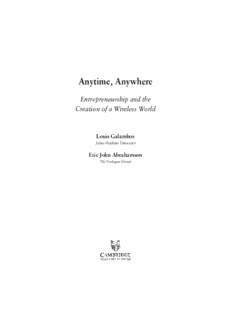
Anytime, Anywhere - Library of Congress PDF
Preview Anytime, Anywhere - Library of Congress
Anytime, Anywhere Entrepreneurship and the Creation of a Wireless World Louis Galambos JohnsHopkinsUniversity Eric John Abrahamson ThePrologueGroup publishedbythepresssyndicateoftheuniversityofcambridge ThePittBuilding,TrumpingtonStreet,Cambridge,UnitedKingdom cambridgeuniversitypress TheEdinburghBuilding,CambridgeCB22RU,UK 40West20thStreet,NewYork,NY10011-4211,USA 477WilliamstownRoad,PortMelbourne,VIC3207,Australia RuizdeAlarcón13,28014Madrid,Spain DockHouse,TheWaterfront,CapeTown8001,SouthAfrica http://www.cambridge.org ©LouisGalambosandEricJohnAbrahamson2002 Thisbookisincopyright.Subjecttostatutoryexceptionand totheprovisionsofrelevantcollectivelicensingagreements, noreproductionofanypartmaytakeplacewithout thewrittenpermissionofCambridgeUniversityPress. Firstpublished2002 PrintedintheUnitedStatesofAmerica TypefaceSabon10/13pt. SystemAMS-TEX [FH] AcatalogrecordforthisbookisavailablefromtheBritishLibrary. Libraryof CongressCataloginginPublicationdataavailable ISBN0521816165 hardback Contents Acknowledgments page vii 1 TheRace 1 2 Bell-heads 12 3 BirthofaWirelessWorld 23 4 InnovationamidRegulatoryChaos 34 5 CaliforniaMiseries 41 6 CanTheyBeEntrepreneurs? 52 7 FirstMover 62 8 BreakingwiththePast 76 9 InnocentsAbroad 81 10 CrisisatHome 95 11 MargaretThatcher’sRevolution 101 12 DeconstructingCulturewhileReconstructingLeadership 108 13 ADigitalHomeRun 113 14 TheTopazSolution 130 15 RiptidesofReform 141 16 AirTouch 150 17 CompetitionfromNewQuarters 159 18 BattlingSystems 174 19 TheWirelessExplosion 183 20 GlobalismRealized? 195 v Contents 21 ASurprisingLong-DistanceCall 200 22 BiddingfortheFutureofaWirelessWorld 214 23 TheMeld 221 24 AGlobalPowerhouse 233 25 TheWirelessWorld 246 Notes 263 Index 301 vi one The Race InthetwilightattheLosAngelesColiseum,sprinterCarlLewisbounced onhistoes,shookhisarmsloose,andthensteppedintotheblocks. From highinthestands,whereSamGinnsat,youcouldpickoutLewiswearing aredUSAsingletandshortsandsportingadistinctivesquare,brush-cut hairstyle. Slowly,thechantsof“USA,USA”subsidedandatensequieten- velopedthestadium. ItwasaperfectsouthernCaliforniaevening,warm andclear. Anightformakinghistory. AlthoughthepoliticsoftheCold Warwereeverpresent–theSovietinvasionofAfghanistan,theU.S.boy- cottoftheMoscowOlympicsin1980,andnowtheabsenceoftheSoviets andtheiralliesfromthegamesin1984–theyseemedbanishedtotheshad- owstonight. Lewishopedtovanquishthoseshadowsbywinningfourgold medals,justashisidolJesseOwenshaddone,triumphingoverpoliticsin Hitler’s1936OlympicsinBerlin. The100-meterdashwasLewis’sfirsttest. Risingwiththecrowdforthestart,SamGinnwatchedtherunnerscome tothesetposition. Tallandtrim,andlookingconsiderablylessthanhis 47years,Ginnrelishedthemoment:thesuddenquietinthestadium,the flickering of the Olympic flame at the western end of the stadium. Like Lewis, Ginn had been born in Alabama. He was raised in Anniston, a small city that embodied many of the disappointed industrial dreams of thepost–CivilWarSouth. Asachildinaworking-classfamily,Ginnhad dreamedofcrossingoverthetrackstothesideofthecitywherebighouses lined the boulevard and where people had the money to travel to events like the Olympics. In high school, sports gave him his first opportunity to enjoy a privileged status, and he had developed a taste for winning. Smart,intenselycompetitive,andpersonable,GinnhadreachedLosAn- gelesbyracingupthecorporateladderoverthecourseofa24-yearcareer 1 Anytime,Anywhere withthelargestcompanyintheworld–AmericanTelephone&Telegraph (AT&T). NowatopexecutivewiththenewlylaunchedenterpriseknownasPa- cificTelesisGroup(oneoftheseven“BabyBells”createdbythebreakup of AT&T), Ginn was a guest at this event, hosted by the company he had spent all of his career serving. As a result of the breakup, AT&T hadbecomePacificTelesis’slargestcustomer,competitor,andsupplierin themarketplacefortelecommunications;itwasAT&Tthathadprovided Ginnwithticketstothistrackandfieldevent. Beingwooedbyhisformer employer,however,wasonlyoneofthemanystrangeaspectsoftheworld Ginn confronted in1984. The settlement in the antitrust suit had com- pletelyrestructuredhiseconomicsetting,seriouslydisruptinghissenseof missionandpurposeinlife. FornearlyaquarterofacenturyheandhispeersintheBellSystemhad believedtheywerethepublicstewardsofoneofthegreatestengineering featsinthehistoryofmankind–thenationaltelephonenetwork.Withthe breakup,however,regulatorsandthecourtshadmadeitclearthatcom- petition,notBellSystemplanners,wouldshapethefuture. Ginnandhis peersintheotherBabyBellswerestilltryingtounderstandwhatkindof futurelayaheadofthem. Manyweregiddywiththeprospectofentering new lines of business and developing the potential of new technologies. Afterall,theyreasoned,theircompanieshadaccesstoenormousamounts ofcapitalandtensofmillionsofexistingcustomers. Thecapabilitiesof theirorganizations,ashistoryhadshown,wereprodigious. Manypeople on Wall Street, however, feared that – because of their size and bureau- cratic organizations – the Baby Bells would lumber down the track and finishfarbehindthefresh-facednewcomerstothetelecommunicationsin- dustry. Ginn favored neither of these two extremes. He was cautiously optimistic about Pacific Telesis and the industry. But in1984 neither he northeotherBellexecutiveshadapositivefixontheirprospects,andnone ofthemcouldpossiblyunderstandhowmuchthepastwouldshapetheir future. ThatfuturewasonGinn’smindattheOlympicsbecausehecarried– whileattendingalloftheevents–adevicethatmostpeoplehadneverseen before. Itwasabrand-new$3,500Motorolaportabletelephone. Known inthefledglingwirelessindustryas“thebrick,”theheavy,putty-colored device with a black face was one of the first portable cellular phones to be offered to consumers. It looked like it should be used by someone at NASA,notbyafaninthestandsoftheLosAngelesColiseum.WhenGinn turnediton,thephonetransmittedradiosignalstoatowerthatwaspart 2 TheRace MartinCooperandtheMotorolaDynaTACphone–WhiletheBellSystemfocused onphonesinvehicles,MartinCooperandhisteamatMotorolaconcentratedon portability. TheresultwastheDynaTAC,knownintheindustryas“thebrick.” ofthecellularwirelessnetworkGinn’scompanyhadracedtocompletein timefortheSummerOlympics. PeoplestaredandlistenedwhenGinnmadeacallfromhisseat. They nudged their friends and pointed. Frequently, Ginn turned and offered themthephone. InawarmvoicethatstillbetrayedtracesofhisAlabama roots,heasked,“Wouldyouliketocallhome?”1Ginnshowedthemhowto punchinthenumbers. Theninevitablytheywouldshouttosomedistant friendorrelative–inauguratingwhatwouldbecomeoneoftheritualsof mobiletelephony–thestatementoflocation:“Youwon’tbelievethis. I’m inthestandsattheOlympics, talkingonthisradiophone.” AJapanese 3 Anytime,Anywhere businessmancalledTokyo. Anothermancalledhiswifethousandsofmiles away. EachwasdelightedinawaythatGinnwouldneverforget. Themobilephonebroughtpeopletogetherandgavethemanewfree- dom. Nolongerforcedtowaituntiltheycould“gettoaphone”toshare newswithfriendsandfamily,peoplecouldreachoutandtouchsomeone fromwherevertheywere. HereinthemidstofthecrowdintheColiseum theycouldreportoneventslive,andthoselisteningontheotherendcould share in that exciting moment. Watching people talk on his phone and passitthroughthestands,SamGinnhadanepiphany. Herecognizedfor thefirsttimethatthesenewphonesrepresentedmorethananincremental improvementonexistingtechnology. Theycreatedawholenewparadigm for communications. For years he had tried to imagine how Alexander Graham Bell must have felt at the beginning of the telephone era, at the realizationthathisnewtechnologycouldbecomebasictothelivesofmil- lionsofpeople. InLosAngeles,Ginnsensedthathewasexperiencingan “AlexanderGrahamBellmoment.” As the gun sounded down on the track, Ginn watched Lewis and the other sprinters bolt out of the blocks. Over the first fifty meters, Lewis laggedbehindthetwoleaders,butthenhechangedgearsandaccelerated. Throwing his arms up at the finish, he won by nearly two meters. Ginn clappedwiththecrowdasLewistookahugeAmericanflagfromafan. He joggedthroughhisvictorylapbeamingandwavingtohischeeringfans. Alreadythesprinterhadembarkedonthepathtohistory.2 Ginn had a sense that day that he, too, was at the start of something big. ButwhileasprinterlikeCarlLewiscouldlookdownthetrack, see his destination, and know what it would take to get there, Ginn faced a moreuncertainfuture. Itwasobviousin1984toeveryoneintelecommu- nicationsthattheindustrywaschangingdramaticallyatthenationaland maybeeventhegloballevel. Butitwasnotatallobviouswhatrolewireless wouldplayinthistransformation. NorwasitclearwhetherPacificTelesis oranyoftheotherexistingfirmsintheindustrywouldbetheleaderswho wouldchampionnewtechnologies,stylesoforganization,orapproaches todoingbusiness. Overthenextfewyears,itwassometimeshardforGinn andhispeerstotellwhatracetheywererunningandwhoexactlywasthe competition. Forconsumersaroundtheworld,however,wirelesswasanobviouswin- ner,aninnovationthatintroducedawholenewwayoflife. Today,there are more cell phones in use than personal computers, and increasingly peopleconnecttotheInternetthroughawirelessdeviceratherthanaPC. Awkward as it was, the Motorola brick was thus launching something 4 TheRace extremelyimportantformillionsofpeople. Itwasnotdesignedforastro- nauts. Atthebeginningofthewirelesserain1984,itallowedanyordinary persontodowhathadbeenapipedreamfordecades–communicatewith anyone,anytime,anywhere. ] Consumerenthusiasmforwirelesspromptedaracetodevelopanewwire- lessworld. Therace,whichisthecentralnarrativeofourstory,tookplace amidstaseriesofdramatictransformationsthatoccurredaroundtheworld intechnology,politics,andtrade,andwehavetriedtodescribethesetran- sitions and the way they played out in wireless. The race was between entrepreneursandtheirorganizations,andwedevoteconsiderableatten- tiontothenatureofthatentrepreneurshipanditsroleinalong-established industryexperiencingsuddenchange. BackinthedarkestdaysoftheGreat Depressionofthe1930s,whenscholarsof“thedismalscience”werestrug- glingtoexplainthecollapseoftheglobaleconomyaswellasthefactors that would lead the world back to happier days, Harvard University re- published a study by Moravian-born economist Joseph Schumpeter. He wasanunusualscholarwhohadmanyyearsbeforeadvancedauniquethe- oryofeconomicdevelopment. Schumpeter’sideasabouteconomicgrowth flewinthefaceofneoclassicalandMarxistexplanations. Innovation,he said,istheengineofeconomicgrowth,andtheagentofinnovationisthe entrepreneur.3Capitalisteconomicprogresswasinherentlyunevenbuten- trepreneurs,ifallowedtocontinue,wouldinevitablyspuranothersurgeof growth. Schumpeter told his readers that entrepreneurs were not intellectuals, tinkers,orinventors. Theywereindividualsinbusinesswhosawthepo- tential for a new product, service, or process, or who perceived the op- portunities in a new source of raw material, a style of organization, or a market. Entrepreneurs also had the temerity to act despite the serious challengestheyfaced. Uncertaintystemmedfromalackofreliabledata. The path ahead was always unclear when innovation was taking place. Doingwhatwasfamiliarwasalwayseasierthandoingsomethingnew. So- cietynormallyresistedchange,makingitdifficultfortheentrepreneurto obtaincapital. Bankswereconservative. Establishedinterests–publicas wellasprivate–thatwerethreatenedbyinnovationthrewuproadblocks to change. Even if buyers could see the benefit of some new product or service,theyoftenpreferredwhattheyalreadyknew. Tosucceed,theen- trepreneur had to overcome the resistance of individuals, organizations, andsometimesanentiresociety. 5 Anytime,Anywhere For the most part, economists, public officials, and the general public ignored Schumpeter’s ideas for decades. He labored away, continuing to elaboratehistheoryandhistoryofcapitalism,butmeanwhileeconomics was transformed in the late1930s and1940s by the ideas of John May- nard Keynes.4 For several decades following the Second World War, the Keynesian model and national planning were the centerpieces of politi- cal economy in the capitalist democracies. In recent years, however, the Schumpeterianperspectiveoneconomicgrowthhasexperiencedaremark- able revival as academics, business leaders, and policymakers – the neo- Schumpeterians–havesoughttounderstandthedynamicsofcapitalism andtheintricaterelationshipsbetweeneconomicgrowthandentrepreneur- shipinindustrieslikewireless.5 ThanksinlargeparttotheresearchofAlfredD.Chandler,RichardNel- son, and other scholars, neo-Schumpeterians recognize that much of the innovationthattakesplaceinmoderncapitalismcomesoutofverylarge corporations. Schumpeterwassuspiciousofgreatcorporatecombines,not becausetheyweremonopolisticbutbecausetheytendedtobeorganized alongbureaucraticlines. Bureaucracy,Schumpetersaid,wastheenemyof theentrepreneur. Itwouldstiflecreativity. Hisidealentrepreneurwasthe greatindividualwho,inthenineteenth-centurystyle,builtanddominated aninnovativebusinessempire. Itremainedforahostofhistorians,econo- mists,andbusinessschoolanalyststoshowhow,inthetwentiethcentury, large corporations began to perform the entrepreneurial function. The mostobviousmanifestationofthismajoreconomictransitionwasindus- trialresearchanddevelopment(R&D),whichyieldednewproductsand newprocesses. Meanwhile,thetopexecutivesandmanagersofthecorpo- rationswereorganizingandreorganizingtheirenterprisesinanongoing efforttoimproveefficiencyandfosterfurtherinnovation. Whilethiswas happening,neithertheoldstyleofheroicentrepreneurnorthesmallinno- vativebusinessdisappeared;bothremainedimportantaspectsofcapitalist development. Buttheycoexistedwithlarge,multinationalenterprisesthat achievedinnovationthroughbureaucraticmeans.6 By political fiat, the modern wireless industry included both types of entrepreneurs. Earlyinthe1980s,theU.S.governmentmadeafatefulde- cision that would turn the development of wireless into a race between thesetwokindsofinnovators. Ineverycityacrossthecountry,twocom- panieswouldbeallowedtooffercellulartelephoneservice. Onewouldbe runbypeople(likeSamGinn)whohadspenttheirentirecareersworking forAT&Torsomesmallerlocaltelephonecompany. Theotherwouldbe launchedbyindividualsandorganizationsfromoutsidetheBellSystem. 6
Description: